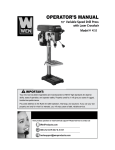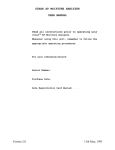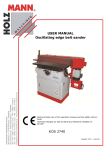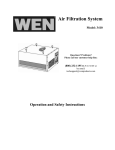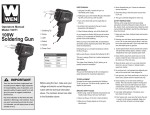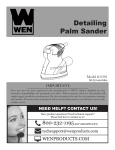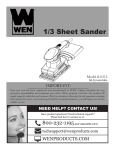Download Wen 6501 Technical data
Transcript
Table of Contents Technical data………………………………………………………………………. General safety rules…………………………………………………………………. Specific safety rules for belt/disc sanders…………………………………………... Electrical information……………………………………………………………….. Know your belt/disc sander…………………………………………………………. Assembly and adjustments…………………………………………………………. . Operation……………………………………………………………………………. Maintenance…………………………………………………………………………. Exploded view…………….………………………………………………………… Parts list……………………………………………………………………………... Warranty……………………………………………………………………………... 2 3 5 7 9 10 16 18 19 20 21 Technical data WEN 4” x 6” Belt/Disc Sander Model: Motor: Speed: 6501 120 V, 60 Hz, 3.5 A Disc: Belt: Belt size: Belt bed tilt: Belt table tilt: Disc diameter: Disc table size: Disc table tilt: Net weight: 1780 RPM 1150 FPM 4" x 36", 80 Grit 0–90° 45–90° 6" 7-1/2" x 5" 0–45° 34 lb Model: 6501 2 wenproducts.com General safety rules Safety is a combination of common sense, staying alert, and knowing how your belt/disc sander works. SAVE THESE SAFETY INSTRUCTIONS. WARNING: To avoid mistakes that could cause serious injury, do not plug in the sander until the following steps have been read and understood. 1. READ and become familiar with this entire instruction manual. LEARN the tool’s applications, limitations, and possible hazards. 2. AVOID DANGEROUS CONDITIONS. Do not use power tools in wet or damp areas or expose them to rain. Keep work areas well-lit. 3. DO NOT use power tools in the presence of flammable liquids or gases. 4. ALWAYS keep your work area clean, uncluttered, and well-lit. DO NOT work on floor surfaces that are slippery. 5. KEEP BYSTANDERS AT A SAFE DISTANCE from the work area, especially when the tool is operating. NEVER allow children or pets near the tool. 6. DO NOT FORCE THE TOOL to do a job for which it was not designed. 7. DRESS FOR SAFETY. Do not wear loose clothing, gloves, neckties, or jewelry (rings, watches, etc.) when operating the tool. Inappropriate clothing and items can get caught in moving parts and draw you in. ALWAYS wear non-slip footwear and tie back long hair. 8. WEAR A FACE MASK OR DUST MASK as the sanding operation produces dust. WARNING: Dust generated from certain materials can be hazardous to your health. Always operate this tool in a well-ventilated area and provide for proper dust removal. Use dust collection systems whenever possible. 9. ALWAYS remove the power cord plug from the electrical outlet when making adjustments, changing parts, cleaning or working on the tool. 10. KEEP GUARDS IN PLACE AND IN WORKING ORDER. 11. AVOID ACCIDENTAL START-UPS. Make sure the power switch is in the OFF position before plugging in the power cord. 12. REMOVE ADJUSTMENT TOOLS. Always make sure all adjustment tools are removed from the sander before turning it on. Model: 6501 3 wenproducts.com General safety rules (continued) 13. NEVER LEAVE A RUNNING TOOL UNATTENDED. Turn the power switch to OFF. Do not leave the tool until it has come to a complete stop. 14. NEVER STAND ON A TOOL. Serious injury could result if the tool tips or is accidentally hit. DO NOT store anything above or near the tool. 15. DO NOT OVERREACH. Keep proper footing and balance at all times. Wear oil-resistant rubber-soled footwear. Keep the floor clear of oil, scrap, and other debris. 16. MAINTAIN TOOLS PROPERLY. ALWAYS keep tools clean and in good working order. Follow instructions for lubricating and changing accessories. 17. CHECK FOR DAMAGED PARTS. Check for alignment of moving parts, jamming, breakage, improper mounting, or any other conditions that may affect the tool’s operation. Any part that is damaged should be properly repaired or replaced before use. 18. MAKE THE WORKSHOP CHILDPROOF. Use padlocks and master switches and ALWAYS remove starter keys. 19. DO NOT operate the tool if you are under the influence of drugs, alcohol, or medication that could affect your ability to use the tool properly. 20. USE SAFETY GOGGLES AT ALL TIMES—that comply with ANSI Z87.1. Normal safety glasses only have impact resistant lenses and are not designed for safety. Wear a face or dust mask when working in a dusty environment. Use ear protection, such as plugs or muffs, during extended periods of operation. Model: 6501 4 wenproducts.com Specific safety rules for belt/disc sanders WARNING: Do not operate this tool until it is completely assembled and installed according to the instructions. 1. This sander is designed to sand wood or wood-like products only. Sanding or grinding other materials could result in fire, injury, or damage to the workpiece. 2. Use the sander on horizontal surfaces only. Operating the sander when mounted on nonhorizontal surfaces might result in motor damage. 3. Fasten the sander securely to a bench top or supporting surface in order to stop it from tipping over or moving when in use. 4. 4. Make sure the sanding belt is installed in the correct direction. See directional arrow on back of belt. 5. Always have the tracking adjusted properly so the belt does not run off the pulleys. 6. Do not use sanding belts or discs that are damaged, torn, or loose. Use only correct size sanding belt and disc. 7. 7. Always hold the workpiece firmly when sanding. Keep hands away from sanding belt or disc. Sand only one workpiece at a time. 8. 8. Always hold the workpiece firmly on the table when using the disc sander and when using the belt sander. 9. 9. Always sand on the downward side of the sanding disc when using the disc sander. Sanding on the upward side of the disc could cause the workpiece to fly out of position, resulting in injury. 10. 10. Always maintain a minimum clearance of 1/16 inch (1.6 mm) or less between the table or backstop and the sanding belt or disc. 11. 11. Do not sand pieces of material that are too small to be safely supported. 12. 12. When sanding a large workpiece, provide additional support at table height. Model: 6501 5 wenproducts.com Specific safety rules for belt/disc sanders (continued) 13. Do not sand with the workpiece unsupported. Support the workpiece with the backstop or table. The only exception is curved work performed on the outer sanding drum. 14. Always remove scrap pieces and other objects from the table, backstop, or belt before turning the sander ON. 15. Never perform layout, assembly or set-up work on the table while the sander is operating. 16. Never use solvents to clean plastic parts. Solvents could dissolve or otherwise damage the material. Use only a soft damp cloth to clean plastic parts. 17. Should any part of your sander be missing, damaged, or fail in any way, or any electrical components fail to perform properly, shut off switch and remove plug from power supply outlet. Replace missing, damaged, or failed parts before resuming operation. 18. Never pull the power cord out of the receptacle. Keep cords away from heat, oil, and sharp edges. 19. Have an electrician replace or repair damaged or worn cords immediately. Model: 6501 6 wenproducts.com Electrical information Grounding instructions IN THE EVENT OF A MALFUNCTION OR BREAKDOWN, grounding provides the path of least resistance for electric current and reduces the risk of electric shock. This tool is equipped with an electric cord that has an equipment grounding conductor and a grounding plug. The plug MUST be plugged into a matching outlet that is properly installed and grounded in accordance with ALL local codes and ordinances. DO NOT MODIFY THE PLUG PROVIDED. If it will not fit the outlet, have the proper outlet installed by an electrician. IMPROPER CONNECTION of the equipment grounding conductor can result in electric shock. The conductor with the green insulation (with or without yellow stripes) is the equipment grounding conductor. If repair or replacement of the electric cord or plug is necessary, DO NOT connect the equipment grounding conductor to a live terminal. CHECK with a licensed electrician or service personnel if you do not completely understand the grounding instructions, or if you are not sure if the tool is properly grounded. USE ONLY THREE-WIRE EXTENSION CORDS that have 3-pronged plugs and outlets that accept the tool's plug as shown in Fig. A. Repair or replace a damaged or worn cord immediately. CAUTION: In all cases, make certain the outlet in question is properly grounded. If you are not sure if it is, have a licensed electrician check the outlet. Model: 6501 7 wenproducts.com Electrical information (continued) Guidelines for using extension cords WARNING: This tool is for indoor use only. Do not expose to rain or use in damp locations. Make sure your extension cord is in good condition. When using an extension cord, be sure to use one heavy enough to carry the current your product will draw. An undersized cord will cause a drop in line voltage resulting in loss of power and overheating. The table below shows the correct size to be used according to cord length and nameplate ampere rating. If in doubt, use the next heavier gauge. The smaller the gauge number, the heavier the cord. Minimum gauge for Extension Cords (AWG) (When using 120V only) Ampere Rating Total Length of Cord in feet More Than Not More Than 25 50 100 150 0 6 18 16 16 14 6 10 18 16 14 12 10 12 16 16 14 12 12 16 14 12 Not Recommended Be sure your extension cord is properly wired and in good condition. Always replace a damaged extension cord or have it repaired by a qualified person before using it. Protect your extension cords from sharp objects, excessive heat and damp or wet areas. Use a separate electrical circuit for your tools. This circuit must not be less than a #12 wire and should be protected with a 15 A time-delayed fuse. Before connecting the motor to the power line, make sure the switch is in the OFF position and the electric current is rated the same as the current stamped on the motor nameplate. Running at a lower voltage will damage the motor. WARNING: This tool must be grounded while in use to protect the operator from electrical shock. Model: 6501 8 wenproducts.com Know Your Belt/Disc Sander Unpacking WARNING: To avoid injury from accidental starting, turn switch OFF and remove plug from power source outlet before making any adjustments. Carefully unpack the belt/disc sander and all its parts, and compare against the list below. Do not discard the carton or any packaging until the belt/disc sander is completely assembled. If any parts are missing or broken, please call our customer service at (888) 315-3080. 1 2 3 10 Machine body Table Disc cover Wrench 4 Stop plate 5 Front cover 6 Rubber pad(4) 7 Miter gauge 8 Aluminum disc 9 Allen wrench Not shown: 1-6” Sanding Disc 1-4” x 36” Sanding Belt (assembled on machine) Model: 6501 9 wenproducts.com Assembly and adjustments Feet Placement 1. 2. Carefully set the Belt/Disc Sander on its side. Press each Rubber Pad (28) over the lip of the Base at each corner. (See Figure 1) Mounting Aluminum Disc and installing a Sanding Disc 1. Use a screwdriver to loosen the 3 screws on the top side of outer pulley cover. (Figure 2) 2. Align the 3 holes on the disc cover with the 3 holes on the outer pulley cover, and fasten the disc cover on the outer pulley cover by 3 screws. (Figure 3) 3. Place the Aluminum Disc on the drive shaft. Align the flat face of the drive shaft with the set screw in the hub of the Aluminum Disc. Fasten set screw with the Allen Wrench provided through the hole on the top of the Disc cover. (Figure 4) Figure 3 Model: 6501 10 wenproducts.com Assembly and adjustments (continued) 4. Peel sanding disc adhesive backing. Align perimeter of new sanding disc over the Aluminum Disc and press firmly onto the Aluminum Disc. NOTE: Before attaching the disc, wipe down the Aluminum Disc with denatured alcohol (shellac thinner). This will clean the surface, leave no residue and assure a secure bond. 5. Use a screwdriver to loosen the 4 screws on the bottom of disc cover. (Figure 5) 6. Align the 4 holes on the disc guard with the 4 holes on the front cover, and fasten them together by 4 screws. (Figure 6) Model: 6501 11 wenproducts.com Assembly and adjustments (continued) Mounting table for use as Disc Sander NOTE: The Table (69) may be used as support for both horizontal and vertical applications. 1. Slide Support Shaft (76) into Bar Holder (74) aligning flat face of the shaft with set screws and tighten securely. Slide Support Shaft (76) into existing hole on side of Machine Body (33) and with wrench (not supplied), tighten Bolt (32). (See Figure 7) Square the table (Figure 8) To ensure accurate end sanding, the work tables must be square to the sanding surfaces prior to using the tables for disc sanding, belt sanding, or vertical belt sanding. 1. Adjust the table to be 90° with the sanding surface. 2. Using a combination square (not provided), place one end on the table with the ruler end against the disc sanding surface. Check that the table is 90° to the disc sanding surface. 3. If the table is not 90° to the sanding surface, loosen adjusting knob (75), adjust the table, tighten the handle and recheck with the square. WARNING: To avoid trapping the workpiece or fingers between the table and the sanding disc, the table edge should be adjusted to a maximum of 1/16 inch from the sanding disc. Model: 6501 12 wenproducts.com Assembly and adjustments (continued) Mounting table for use as belt sander NOTE: The Table (69) may be used for both horizontal and vertical operations. 1. Remove Table from Machine Body using reverse procedures in step 1 of “Mounting table for use as disc sander” section above. 2. Set Belt/Disc Sander in vertical position by loosening both Nuts (22). Raise the Belt Support Housing (52). When it is vertical, tighten both Nuts (22) very tight to prevent the Belt Support Housing (52) from slipping. (See Figures 9 & 10) 3. Insert Support Shaft (76) into the hole facing the belts and tighten Bolt (32) against flat side of Support Shaft (76). (See Figures (9 & 10) Model: 6501 13 wenproducts.com Assembly and adjustments (continued) Mounting stop plate This Stop Plate (63) fits across the top of the sanding belt and is for preventing workpiece from moving to the rear when sanding. 1. 2. 3. Align the two Tabs on the Stop Plate (63) with the two Holes on the top of the Band Support Housing (52). The Tabs will be underneath the Flange on the Band Support Housing (52). Insert two Machine Screws into the two Holes and thread them into the Tabs on the Stop Plate (63). Mount the Stop Plate (63) to the Band Support Housing (52) using Bolt (32), Flat Washer (26) and Lock Washer (27). (See Figure 11) Square the stop plate (Figure 12) The stop plate (63) must be square to the sanding belt when using the belt sander in a horizontal position. To keep the workpiece from being carried along the belt: 1. Make sure the sanding belt is tight; also check that the tension handle is fully tightened. 2. Place the combination square (not provided) on the belt with the ruler against the stop plate (63). 3. Adjust by loosening the stop plate locking bolt (32), square the backstop. 4. Tighten the stop plate locking bolt (32). WARNING: To avoid trapping the workpiece or fingers between the sanding belt and the stop plate, the stop plate edge should be adjusted to a maximum of 1/16 inch from the sanding belt. Model: 6501 14 wenproducts.com Assembly and adjustments (continued) Install the sanding belt 1. 2. 3. Push the Belt Tension Handle (50) forward to loosen the belt. Remove Upper Guard Plate (58) by unscrewing four Screws (7). Remove the Lower Guard Plate (60) by unscrewing the four Screws (7) that hold it to the Belt Support Housing (52). 4. Slide the old sanding belt off the Rear Roller (56) and Front Roller (44). 5. Replace with a 4” X 36” sanding belt with the correct grit for the project you are working on. NOTE: The larger the grit number, the smaller the grain. Use small numbered grits for cutting and larger for smoothing and finishing. 6. Slide new sanding belt onto Front and Rear Rollers. Make sure the direction of the sanding belt matches the direction of the belt rotation. 7. Replace the Lower Guard Plate (60) and tighten the four Screws (7) securely. 8. Replace the Upper Guard Plate (58) and tighten the four Screws (7). 9. Push the Belt Tension Handle (50) to the rear to tighten the belt. 10. Before using, check the new belt for alignment. See next section for detail. Sanding belt tracking adjustment 1. 2. Plug in the power cord. Turn the switch ON and OFF to make sure the sanding belt is correctly centered and not sliding off the Front and Rear Rollers (44 and 56). 3. If the belt looks like it is going to slide off either roller, it needs to be adjusted. 4. Turn the Belt Adjustment Knob (49) until the belt rides the center of the Rear Roller (56) and the Front Roller (44). 5. Turn the switch ON and OFF again; readjust the Belt Adjustment Knob (49) if necessary. Install a sanding disc 1. 2. 3. 4. Remove the Table (69), if it is mounted in front of the sanding disc. Remove the Front Cover (3). Peel off old sanding disc. Peel new Sanding Disc adhesive backing. Align perimeter of new sanding disc over the Aluminum Disc (5) and press firmly onto the Aluminum Disc (5). NOTE: If you are using the sanding disc for the first time. Before attaching the disc, wipe down the Aluminum Disc (5) with denatured alcohol (shellac thinner). This will clean the surface, leave no residue and assure a secure bond. Model: 6501 15 wenproducts.com Operation ON/OFF switch (Figure 13) The keyed switch is intended to prevent unauthorized use of the sander. WARNING: Remove the safety key whenever the sander is not in use. Place the key in a safe place and out of the reach of children. 1. To turn sander ON, insert the safety key into the key slot in the center of the switch. 2. Push key firmly into the slot, then push switch to the ON position to start the sander. 3. To turn the sander OFF push switch to the OFF position. 4. Remove the safety key when the sander has come to a complete stop by gently pulling it forward and out. Surface or edge sanding on sanding belt (Figure 14) Hold the workpiece firmly with both hands. Keep fingers away from sanding belt. Keep the workpiece end against the backstop and move it slowly across the sanding belt. Apply enough pressure to remove material; excessive pressure will reduce sanding efficiency. Model: 6501 16 wenproducts.com Operation (continued) Sanding inside curves (Figure 15) Sanding the inside curve of the workpiece is done by positioning the workpiece on the idler pulley of the sanding belt. Hold workpiece firmly with both hands. End sanding and outside curve sanding with the disc (Figure 16) Use for sanding the ends of small and narrow workpieces and outside curved edges. Always work on the left side of the disc (downward rotation side), holding the workpiece firmly with light pressure against the sanding disc. Note: Always maintain a maximum of 1/16” clearance between the Table and sanding disc. CAUTION: To avoid personal injury and/or damage to the workpiece, become familiar with the rotation of the belt and disc sanding surfaces. The belt sander rotates counterclockwise or downward toward the table or stop plate. The disc sander rotates counterclockwise, downward toward the table on the left side of the disc and upward from the table on the right side of the disc. Always use the left side of the disc; using the right side of the disc will cause the workpiece to fly up or kickback and could result in injury. Review this instruction manual for correct operation, adjustments, and basic sanding operations. CAUTION: When finished with Belt/Disc Sander, to prevent accidents, turn off and disconnect its power supply after use. Remove the safety Key from the Switch (31). Wipe down and store the Sander indoors out of children’s reach. Model: 6501 17 wenproducts.com Maintenance WARNING: For your own safety, turn the switch OFF and remove the plug from the electrical outlet before adjusting or performing maintenance or lubrication work on the belt/disc sander. Before using, check to make sure parts are not damaged, missing, or worn; check for alignment of moving parts, binding of moving parts, improper mounting, or any other conditions that may affect the sander operation. Should any of these conditions exist, do not use the sander until properly repaired or parts are replaced. Frequently blow or vacuum dust from all sanding parts and motor housing. WARNING: Any attempt to repair or replace electrical parts on this tool may be hazardous. Repairs should be done by a qualified service technician. Lubrication Ball bearings are grease packed at the factory and require no further lubrication. Sleeve bearings on both ends of the idler pulley should be oiled with 3 drops of 30 weight oil after each 10 hours of operation. Use a spray lubricant on all moving table parts to ensure smooth operation. Adjust the Drive belt tension 1. Remove Set Screws (6) and pull off Aluminum Disc (5). 2. Remove four Screws (11) and Washers (10) from Outer Pulley Cover (9). 3. Loosen four Motor Mount Nuts (22) and slide the Motor (40) further forward towards Front Roller (44), making sure to pull evenly on the motor. While holding the motor in its current position, tighten the Nuts (22). 4. Place a straight edge on the faces of the two pulleys to ascertain alignment. Contact surfaces of the pulleys and the straight edge shall fully touch. Fully tighten the Nuts (22). Model: 6501 18 wenproducts.com Exploded view Model: 6501 19 wenproducts.com Parts list Item # 1 2 3 4 5 6 7 8 9 10 11 12 13 14 15 16 17 18 19 20 21 22 23 24 25 26 27 28 29 30 31 32 33 34 35 36 37 38 Part # 6501-001 6501-002 6501-003 6501-004 6501-005 6501-006 6501-007 6501-008 6501-009 6501-010 6501-011 6501-012 6501-013 6501-014 6501-015 6501-016 6501-017 6501-018 6501-019 6501-020 6501-021 6501-022 6501-023 6501-024 6501-025 6501-026 6501-027 6501-028 6501-029 6501-030 6501-031 6501-032 6501-033 6501-034 6501-035 6501-036 6501-037 6501-038 Model: 6501 Description Screw M4 X 12 Flat Washer 4 Front Cover Sander Disc Aluminum Disc Set Screw Screw M4 X 8 Disc Cover Outer Pulley Cover Washer Screw M4 X 8 V-Belt Motor Pulley Spindle Pulley Screw M8 X 6 Bolt M6 X 12 Lock Washer Flat Washer Screw M5 X 20 Inner Pulley Cover Spacer Nut 8 Supporting Rod Nut 10 Base Flat Washer 8 Lock Washer 8 Rubber Pad Screw M5 X 12 Flat Washer 5 ON/OFF Switch Bolt M8 X 16 Machine Body Rubber Cap Steel Plate Holding Plate Cable Fixing Plate Hold Plate Bolt Qty 9 27 1 1 1 1 14 1 1 16 6 1 1 1 2 6 7 7 3 1 1 6 1 1 1 9 8 4 5 5 1 8 1 1 1 1 1 1 Item # 39 40 41 42 43 44 45 46 47 48 49 50 51 52 53 54 55 56 57 58 59 60 61 62 63 64 65 66 67 68 69 70 71 72 73 74 75 76 20 Part # 6501-039 6501-040 6501-041 6501-042 6501-043 6501-044 6501-045 6501-046 6501-047 6501-048 6501-049 6501-050 6501-051 6501-052 6501-053 6501-054 6501-055 6501-056 6501-057 6501-058 6501-059 6501-060 6501-061 6501-062 6501-063 6501-064 6501-065 6501-066 6501-067 6501-068 6501-069 6501-070 6501-071 6501-072 6501-073 6501-074 6501-075 6501-076 Description Rubber Tube Motor Washer 5 Retaining Ring 12 Ball Bearing Front Roller Adjusting Bracket Spring Shaft Spring Belt Adjustment Knob Belt Tension Handle Screw M6 X 12 Belt Support Housing Coach Bolt M8 X 35 Drive Shaft Bearing Housing Rear Roller Left Bearing Housing Upper Guard Plate Dust Port Lower Guard Plate Screw Belt Sander Stop Plate Knob M5 X 16 Miter Gauge Screw M5 X 6 Pointer Sliding Bar Table Pivot Indicator Hex Bolt M8 X 10 Table Bar Angle Pointer Bar Holder Adjusting Knob Supporting Shaft wenproducts.com Qty 1 1 4 2 4 1 1 1 1 1 1 1 1 1 2 1 1 1 1 1 1 1 3 1 1 1 1 1 1 1 1 1 1 1 1 1 1 1 Warranty WEN Products warrants its power tools to be free of defects from materials and workmanship for a period of one (1) year from date of original purchase. We will repair or replace, at our option, any tool covered by this warranty that after inspection is found to be defective in materials or workmanship during the warranty period. If the product is used for commercial, professional or income producing purposes, the limited warranty period is 90 days. The limited warranty period is 30 days when the product is used for rental purposes. This limited warranty applies only to the original owner and is not transferable to subsequent owners. The limited warranty begins on the date of purchase by the original owner and extends for the fore-mentioned time periods. This limited warranty does not apply if the tool has been misused, abused, subject to an accident, altered or repaired by others not authorized. Normal wear and tear is also not covered by this warranty. To take advantage of this warranty, please contact us at 1-888-315-3080 or write to us at WEN. PO Box 1110, Dundee, IL 60118. You will need proof of purchase and may be asked to ship the tool back to us freight prepaid. Under no circumstances shall WEN Products be liable for any indirect, incidental or consequential damages from the sale or use of this product. Some states do not allow the exclusion or limitation of incidental or consequential damages. Some states do not allow limitations on the length of an implied warranty. This warranty provides you with specific legal rights and you may have other rights that vary from state to state. Model: 6501 21 wenproducts.com





















